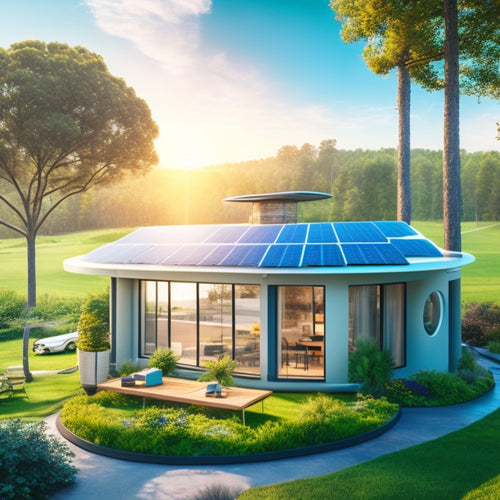
Honda's Electric SUV & EV Charging Explained
Share
Honda's first fully-electric SUV, the Prologue, debuts in 2024, marking a significant milestone in the company's commitment to sustainable transportation and electric vehicle technology. This eco-friendly vehicle reduces carbon footprint and emissions, offering a smooth and quiet ride with advanced technology. Understanding EV charging basics is essential, with options including Level 1, Level 2, and Quick Charging. Honda's network provides access to charging stations, including EVgo, Electrify America, and ChargePoint, with a charging station map and varying payment methods. As you explore the world of electric vehicles, discover more about Honda's innovative solutions for a sustainable future.
Key Takeaways
• Honda's Prologue is a fully-electric SUV, set to debut in 2024, reducing carbon footprint and emissions with its rechargeable battery.
• There are three EV charging options: Level 1 (slow, convenient), Level 2 (faster, often in commercial lots), and Quick Charging (fastest, limited stations).
• Honda's network includes stations from EVgo, Electrify America, and ChargePoint, with a map on the Honda website or app to locate stations.
• Users can filter charging stations by location, charger type, and payment options, with varying payment methods including credit cards, subscriptions, or memberships.
• Plugging in and starting a charging session is simple with Honda's network, making EV charging convenient and accessible.
Honda's Electric SUV Overview
What can consumers expect from Honda's inaugural foray into the electric vehicle market with the introduction of the Prologue in 2024?
The Prologue marks a significant milestone in Honda's commitment to sustainable transportation.
As a fully-electric SUV, it boasts impressive performance features, including a rechargeable battery that eliminates tailpipe emissions and the need for gas.
This eco-friendly vehicle offers a guilt-free driving experience, reducing carbon footprint and promoting environmental benefits.
The Prologue's electric powertrain guarantees a smoother, quieter ride, while its advanced technology provides a seamless driving experience.
With its debut, Honda is poised to make a significant impact in the electric vehicle market, catering to consumers seeking sustainable and environmentally responsible transportation options.
Understanding EV Charging Basics
Electric vehicle (EV) charging is an essential aspect of owning an electric car, and understanding the basics is important for a seamless driving experience.
When it comes to charging, there are three main options: Level 1, Level 2, and Quick Charging (Level 3).
Level 1 charging uses a standard household outlet and is the most convenient method, but it's also the slowest.
Level 2 charging is faster and commonly found in commercial parking lots, but may require a paid subscription.
Quick Charging is the fastest option, but only available at dedicated stations.
Understanding the benefits and requirements of each charging type is crucial.
For instance, Level 2 charging speeds up the process, but may require professional installation at home.
A thorough understanding of EV charging basics enables drivers to make informed decisions and optimize their charging experience.
Finding and Using Charging Stations
Honda's extensive network of charging stations provides convenient access to recharge on the go. This network includes stations from EVgo, Electrify America, and ChargePoint. To find a charging station, drivers can utilize a charging station map, available on the Honda website or mobile app.
This map allows users to filter by location, charger type, and payment options, making it easy to plan their route. Payment options vary by station, with some accepting credit cards, while others require a subscription or membership.
Once at the station, simply plug in and initiate the charging session using the station's interface or mobile app. With Honda's widespread network, finding and using charging stations has never been easier.
Frequently Asked Questions
Can I Install a Level 2 Charger in My Garage Myself?
When contemplating a DIY Level 2 charger installation in your garage, make sure proper Garage Preparation and adhere to DIY Safety guidelines to avoid electrical hazards, guaranteeing a safe and efficient charging experience.
How Much Does It Cost to Charge an Electric Vehicle per Mile?
The cost to charge an electric vehicle per mile varies, but on average, it's around 4-5 cents per mile, depending on the vehicle's energy efficiency and local electricity rates, making it a cost-effective option compared to traditional gasoline-powered vehicles.
Can I Charge My Electric Vehicle in the Rain or Snow?
Electric vehicles can be safely charged in rain or snow, as charging ports and plugs are designed with waterproof materials and weather-resistant seals, ensuring reliable and secure connections in various environmental conditions.
Are Electric Vehicles More Expensive to Maintain Than Gas-Powered Cars?
"Electric vehicles typically have lower maintenance costs due to fewer moving parts, but battery replacement costs can be high. However, improved fuel efficiency and reduced wear on brakes and tires can offset these costs, making EVs a cost-effective option."
Do Electric Vehicles Have Fewer Moving Parts Than Gas-Powered Cars?
"Bite the bullet" and acknowledge that electric vehicles indeed have fewer moving parts than gas-powered cars, thanks to their simpler design, which translates to increased reliability and reduced maintenance needs.
Related Posts
-

3 Sun-Powered Automated Shades for Energy-Savvy Homes
You're looking to change your home into an energy-savvy haven, and sun-powered automated shades are an essential step...
-

Green Deck Options: Earth-Conscious Choices for Your Home
You're looking for a deck that not only enhances your home's exterior but also aligns with your eco-friendly values. ...
-

Gamify Your Home's Energy Generation and Savings
You're taking the next step in optimizing your home's energy generation and savings by utilizing the power of gamific...


